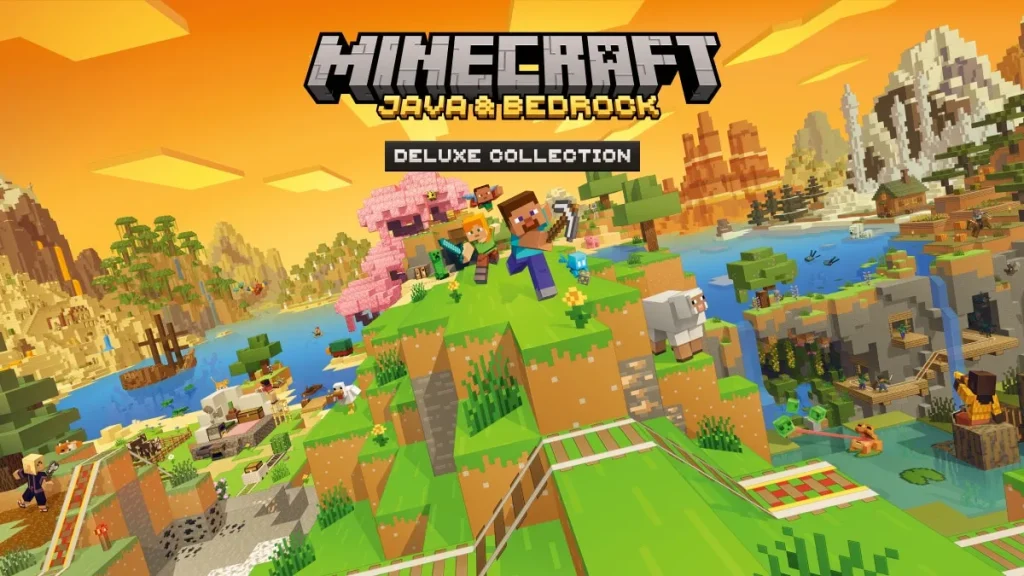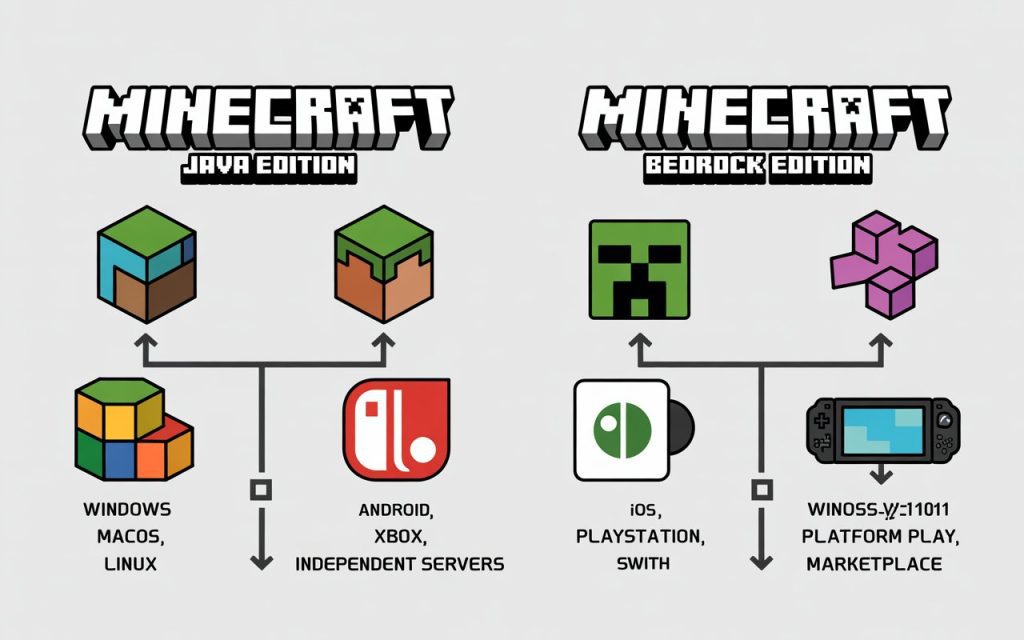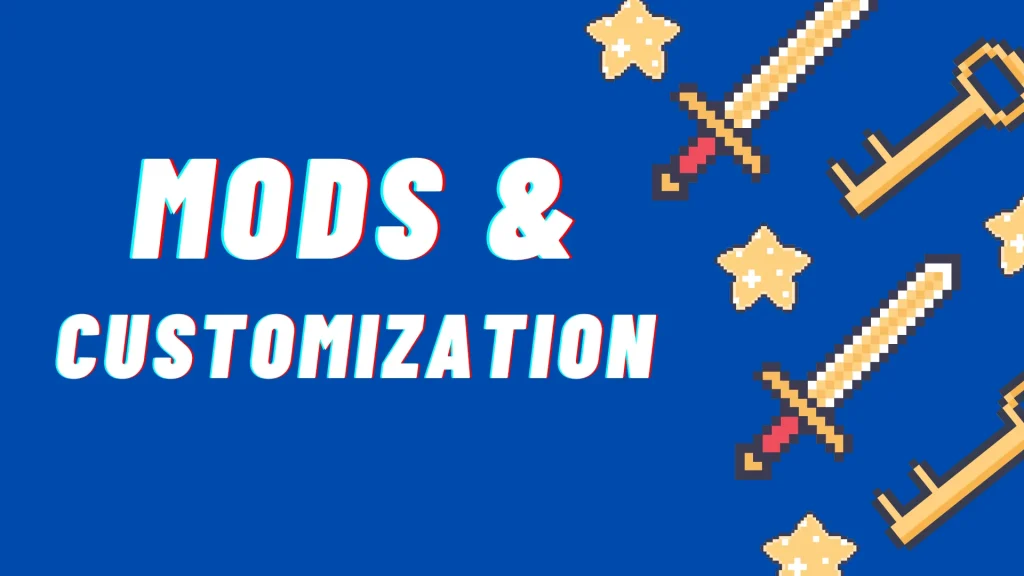Minecraft. The name alone conjures images of blocky landscapes, endless creativity, and maybe the occasional creeper lurking just out of sight. For over a decade, this sandbox phenomenon has captivated millions across the globe. But as Minecraft expanded from its PC origins to consoles and mobile devices, a common question arose: Is the mobile version just as good as the classic PC experience? Or perhaps, is it even better?
If you’re wrestling with this dilemma – trying to decide whether to dive into Minecraft on your phone or stick to your computer – you’ve come to the right place. The answer isn’t always straightforward, because the real difference often lies not just between mobile and PC, but between two fundamental editions of the game: Java Edition and Bedrock Edition.
Understanding this core distinction is key. Mobile versions (on iOS and Android) exclusively run on the Bedrock engine. Meanwhile, PCs (Windows, macOS, Linux) are the traditional home of Java Edition, but modern Windows PCs can also run the Bedrock Edition, often bundled together. This guide will break down the crucial differences – from platform availability and cross-play capabilities to mods, controls, cost, and more – helping you navigate the blocky landscape and choose the Minecraft version that perfectly suits your playstyle, your platform, and your friends in 2025.
Understanding the Basics: Java vs. Bedrock Explained

Before diving into the specifics of mobile versus PC, it’s crucial to grasp the fundamental difference that underpins most comparisons: the distinction between Minecraft’s two main editions, Java and Bedrock. Originally, Minecraft was a PC-exclusive game built using Java. As its popularity exploded, Mojang Studios (the developers) sought to bring the experience to other platforms like consoles and mobile devices. This led to the creation of a separate version built on a different codebase (C++), designed for broader compatibility and performance across various hardware. This version became known as the Bedrock Edition.
Java Edition:
This is the original Minecraft, available only for Windows, macOS, and Linux computers. It’s renowned for its massive modding community, extensive customization options, and access to a vast array of independent multiplayer servers. If you hear veteran players talking about complex mods or specific server types, they’re likely referring to Java Edition.
Bedrock Edition:
This is the engine that powers Minecraft on mobile devices (iOS, Android – formerly known as Pocket Edition or PE), consoles (Xbox, PlayStation, Nintendo Switch), and Windows 10/11 PCs. Its major advantage is unification and cross-platform play, allowing someone on an Xbox to play with a friend on their smartphone or Windows PC. It features a curated Marketplace for add-ons, skins, and worlds, making customization more accessible but less expansive than Java’s modding scene.
So, when we talk about “Minecraft Mobile,” we are always talking about the Bedrock Edition. When we talk about “Minecraft PC,” it could mean either Java Edition or the Bedrock Edition running on a Windows PC. This distinction is the key to understanding the differences in features like cross-play, mods, and server access.
Platform Availability: Where Can You Play?
Your choice of Minecraft edition might be dictated simply by the devices you own. Here’s the breakdown:
- Minecraft: Java Edition: As mentioned, this is exclusive to personal computers running Windows, macOS, or Linux.
- Minecraft: Bedrock Edition: This version boasts much wider availability, running on:
- Windows 10/11 PCs
- Xbox One, Xbox Series S, and Xbox Series X
- PlayStation 4 and PlayStation 5
- Nintendo Switch
- iOS devices (iPhone, iPad)
- Android devices (phones, tablets)
- Historically, it also supported platforms like Windows Mobile and Amazon Fire tablets.

The clear advantage for PC players, specifically those on Windows 10 or 11, is that they can access both editions. In fact, Mojang now typically sells “Minecraft: Java & Bedrock Edition for PC,” bundling both versions for a single price, giving Windows users the ultimate flexibility.
Cross-Play: Playing with Friends Across Devices
This is often the deciding factor for many players. Can you, playing on your phone, join your friend who’s on their PC or console? The answer depends entirely on the editions being used.
- Bedrock’s Strength: Yes, Bedrock Edition is designed for cross-play. If you and your friends are all using the Bedrock Edition, you can play together regardless of whether you’re on an iPhone, an Android tablet, an Xbox, a PlayStation, a Switch, or a Windows PC. This seamless multiplayer experience across different hardware is a major selling point for Bedrock.
- Java’s Limitation: Java Edition players can only play with other Java Edition players on PC (Windows, macOS, or Linux).
- The Great Divide: Crucially, there is no cross-play between Java Edition and Bedrock Edition. A Java player cannot join a Bedrock player’s world or server, and vice-versa. This is the single most important compatibility issue to be aware of. If playing with specific friends is your priority, you must ensure everyone is using the same edition (or that PC players use Bedrock if they want to join mobile/console friends).
- Console Consideration: It’s also worth noting that playing online multiplayer on consoles (Xbox, PlayStation, Switch) typically requires a paid subscription service for that platform (like Xbox Live Gold/Game Pass Core, PlayStation Plus, or Nintendo Switch Online). Online play on PC (Java or Bedrock) and Mobile (Bedrock) generally only requires an internet connection.
Mods and Customization: Tailoring Your World

How much do you want to change the look, feel, and mechanics of your Minecraft world? The answer significantly diverges between the two editions.
Java’s Powerhouse:
Java Edition is the undisputed king of customization. Thanks to its open nature, a massive community has developed hundreds of thousands of free modifications (mods). These range from simple visual tweaks and performance enhancements (like OptiFine) to complete overhauls that add new dimensions, magic systems, complex machinery, and entirely new gameplay loops. You can also easily install custom skins and download countless user-created maps. The catch? Installing mods often requires a bit of technical know-how (using launchers like Forge or Fabric) and managing compatibility between mods can sometimes be tricky.
Bedrock’s Marketplace:
Bedrock Edition takes a more curated and user-friendly approach. It features the official Minecraft Marketplace, an in-game store where players can browse and purchase (using a virtual currency called Minecoins, bought with real money) a wide variety of content created by Mojang partners and approved creators. This includes skin packs, texture packs, adventure maps, survival spawns, and even add-ons that introduce new behaviors or creatures. While easier to access and guaranteed to work, the selection is more limited compared to Java’s modding scene, and the content typically costs money.
If deep, game-altering customization and a free-for-all modding environment are what you seek, Java Edition on PC is the way to go. If you prefer simpler, officially sanctioned cosmetic changes and gameplay additions accessible directly within the game, Bedrock (on any platform) offers a streamlined experience via the Marketplace.
Servers and Multiplayer: Joining Online Communities
Beyond playing with direct friends, joining larger online servers offers persistent worlds and unique game modes. Access differs between editions:
- Java’s Variety: Java Edition boasts access to an enormous number of independent, third-party multiplayer servers. These range from massive networks offering dozens of minigames (like Hypixel) to smaller, community-focused survival servers, creative plots, role-playing servers, and highly modded experiences. Finding and connecting usually involves looking up server IP addresses online.
- Bedrock’s Structure: Bedrock Edition features a list of official partner servers directly accessible from the main menu, offering popular game modes and requiring a Microsoft account. It also supports Realms and Realms Plus, Mojang’s official, easy-to-use, subscription-based server hosting service for playing privately with friends (up to 10 simultaneous players). While the third-party server scene for Bedrock is growing, it’s generally less vast and diverse than Java’s.
- Local Play: For couch co-op, only the console versions of Bedrock Edition support local split-screen multiplayer.
Java offers unparalleled server variety for PC players. Bedrock provides easier access to featured servers and simple private hosting via Realms, making it convenient for cross-platform friend groups on mobile, console, and Windows PC.
Controls: How You Interact with the World
The way you move, build, and fight in Minecraft depends heavily on your platform and edition:
- PC Standard (Java & Bedrock): The traditional keyboard and mouse setup offers precision aiming, quick inventory management, and customizable keybinds, generally considered optimal for complex building and combat.
- Mobile Standard (Bedrock): Touchscreen controls involve on-screen buttons and gestures. While functional and improved over the years, they can lack the precision and speed of physical inputs, especially for combat or intricate building. Many find them more intuitive for casual play or navigation.
- Console Standard (Bedrock): Game controllers provide a comfortable and familiar experience for many, balancing ease of movement with decent control over actions. Inventory management can sometimes feel slower than with a mouse.
- Flexibility: Thankfully, Bedrock Edition often supports multiple input methods. You can typically connect and use a compatible game controller with the mobile versions or even on PC Bedrock. Some limited keyboard/mouse support might also exist on certain Bedrock platforms, but keyboard/mouse remains the native and most optimized input for PC Java/Bedrock.
Your preferred control scheme might heavily influence your choice. If precision keyboard/mouse control is paramount, PC (Java or Bedrock) is ideal. If portability and touch controls are fine, mobile works well. If you love controllers, consoles or PC/Mobile Bedrock with a controller are great options.
Cost and Monetization: What’s the Price Tag?
How much does it cost to get into Minecraft and keep playing?
- Base Game Price: Historically, the mobile Pocket Edition was significantly cheaper than the PC or console versions. Nowadays, the pricing is often closer, especially with the Java & Bedrock bundle on PC. However, the mobile versions on iOS and Android are still generally the most affordable entry point for the base game.
- Ongoing Costs – Java: Beyond the initial purchase, Java Edition is largely free. The vast majority of mods, skins, and maps are created by the community and offered for free.
- Ongoing Costs – Bedrock: While the base game might be affordable, Bedrock Edition incorporates the Minecraft Marketplace. Accessing many skins, texture packs, adventure maps, and add-ons requires purchasing Minecoins with real money. While optional, this can add up if you frequently want new content. Realms/Realms Plus subscriptions for private servers also carry a monthly fee.
Mobile Bedrock offers the lowest initial cost. Java has minimal ongoing costs if you stick to free community content. Bedrock’s costs can increase if you utilize the Marketplace or subscribe to Realms.
Updates and Features: Staying Current
Both editions of Minecraft receive the same major content updates (like the recent Tricky Trials update), bringing new blocks, mobs, and biomes to all players eventually. However, there are differences in how players can access upcoming features and older versions:
- Early Access – Java: Java Edition players can opt into Snapshots. These are experimental development builds released periodically, allowing players to test upcoming features early. Snapshots can be unstable and potentially corrupt worlds, so caution is advised. Java also has an “Experimental Features” toggle for testing specific new mechanics in a controlled way.
- Early Access – Bedrock: Bedrock players can access Previews (on most platforms) or Betas (on Android). These function similarly to Snapshots, offering early access to new content, but are often delivered through a separate app (Previews) or an opt-in system (Betas), generally posing less risk to your main game worlds.
- Version Access: A unique feature of Java Edition is the ability to easily switch between and play almost any previous version of the game through the official launcher. Bedrock Edition players are generally limited to playing the latest stable release or the current Preview/Beta version.
While both get the same core updates, Java offers more flexibility in accessing development builds and historical versions, whereas Bedrock’s early access is often slightly more stable and compartmentalized.
Performance and Graphics: How Does It Look and Run?
Does Minecraft look or run better on mobile or PC? This is highly dependent on the hardware involved.
- Hardware is King: A high-end gaming PC running either Java or Bedrock will vastly outperform Minecraft running on an older smartphone. Conversely, a modern flagship phone might run Bedrock more smoothly than an old, low-spec laptop running Java.
- Core Aesthetics: The fundamental blocky art style is consistent across both editions.
- Minor Differences: There can be subtle differences in lighting, rendering, and particle effects. Some argue Bedrock can look slightly cleaner or more vibrant out-of-the-box on capable hardware, while Java, especially with performance mods like Sodium or OptiFine, can achieve extremely high frame rates and offer more graphical customization options (like shaders, which dramatically alter the game’s appearance).
- Optimization: Bedrock was built with broader hardware compatibility in mind, potentially leading to better performance on lower-end systems compared to unmodded Java. However, modded Java can often be optimized beyond what Bedrock offers.
Ultimately, performance is tied to your specific device. Don’t expect parity between a phone and a powerful PC. While minor visual distinctions exist, the core look remains iconic on both Java and Bedrock.
Which Version is Right for You?
So, after exploring all those differences, how do you actually choose? It boils down to your priorities:
Choose Minecraft: Java Edition (PC Only) if:
- Mods are a must: You want access to the vast, free library of community-made mods to fundamentally change or enhance your gameplay.
- Server variety is key: You want to join diverse, independent multiplayer servers, including heavily modded ones.
- You only play on PC: You don’t need to connect with friends on consoles or mobile.
- You value deep customization: You enjoy tinkering with game files, using custom skins freely, and potentially playing older game versions.
- You prefer minimal ongoing costs: You’re happy with the free community content and don’t want an in-game marketplace.
Choose Minecraft: Bedrock Edition (Mobile, Console, Windows PC) if:
Cross-play is essential: Your main goal is to play with friends who are on different devices (Xbox, PlayStation, Switch, Mobile, Windows PC).
- Portability matters: You want to play Minecraft on the go on your phone or tablet.
- Simplicity and ease-of-use are preferred: You want easy access to curated content via the Marketplace and straightforward multiplayer setup (Realms, featured servers).
- You play primarily on console: Bedrock is your only option on Xbox, PlayStation, and Switch.
- You prefer controller or touch controls: These are native input methods for console and mobile Bedrock.
- You’re a beginner or buying for younger players: The lower initial cost on mobile and the curated nature of the Marketplace can be appealing.
The PC Player’s Dilemma (Windows 10/11):
If you have a capable Windows PC, you have the luxury (and sometimes confusion) of choosing either Java or Bedrock, or using both thanks to the bundle. Your decision here hinges on:
- Who are you playing with? If your friends are on consoles/mobile, you need Bedrock. If they’re on PC Java, you need Java.
- Do you want mods? If yes, Java is the clear winner.
- Do you prioritize seamless cross-play or curated content? If yes, Bedrock might be more convenient.
Many PC players end up using both editions depending on the situation!
Conclusion: Your Minecraft, Your Choice
Ultimately, the debate of “Minecraft Mobile vs. PC” isn’t about declaring one definitively superior. Both the mobile (Bedrock) and PC (Java and/or Bedrock) experiences offer the core magic of Minecraft – building, exploring, surviving, and creating. The “better” version is simply the one that aligns best with how you want to play, where you want to play, and who you want to play with.
The core trade-off remains clear: Java Edition offers unparalleled depth in customization and modding primarily for the PC player. Bedrock Edition provides incredible accessibility, allowing players across a vast range of devices – from phones to consoles to Windows PCs – to connect and share their blocky adventures seamlessly.
Consider your priorities: Is it the boundless freedom of mods, the convenience of playing anywhere, or the joy of joining friends regardless of their device? Once you know what matters most to you, the choice between Java and Bedrock, and consequently between mobile and PC, becomes much clearer. Now go forth and craft your world!
